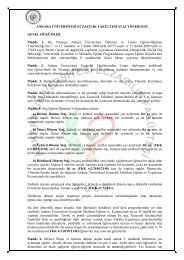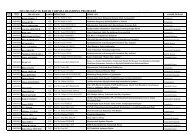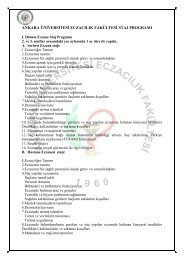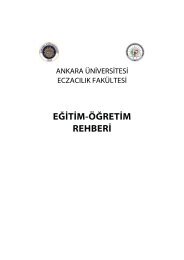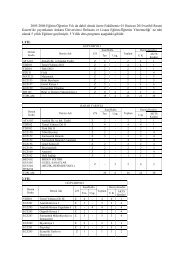Faculty of Pharmacy
Faculty of Pharmacy
Faculty of Pharmacy
Create successful ePaper yourself
Turn your PDF publications into a flip-book with our unique Google optimized e-Paper software.
Myorelaxant and antiepileptic drugs, Antidepressant drugs, Narcotic analgesic drugs, Non-narcotic<br />
analgesic drugs ,Non-steroidal Anti-inflammatory Drugs.<br />
(ECZ386) PHARMACETICAL CHEMISTRY II (T)<br />
HOUR/WEEK :3, ECTS :4<br />
Pharmaceutical Chemistry II provides the general aspects <strong>of</strong> drug molecules consisting <strong>of</strong> their<br />
chemical structures, chemical nomenclature, physicochemical properties, synthesis schedules,<br />
metabolism, stabilities, chemical analysis and their interaction with biological systems. Under this<br />
generalization, chemotherapy and chemotherapeutics, beta-lactam antibiotics, beta-lactamase<br />
inhibitors, antibiotics derived from polypeptides, macrolitics, aminoglycosites, other antibiotics<br />
(tetracyclines, chloramphenicol), sulfonamides, quinolone compounds, antituberculosis drugs,<br />
antifungals, antiviral drugs and antineoplastic drugs, are counted.<br />
(ECZ387) PHARMACEUTICAL CHEMISTRY PRACTISE I (P)<br />
HOUR/WEEK :4, ECTS:2<br />
The experimental studies <strong>of</strong> Pharmaceutical Chemistry I covers the generalized topics for laboratory<br />
safety, laboratory devices and the usage techniques along with separation <strong>of</strong> organic molecules and<br />
purification in which a) Crystallization, b) Extraction, c) Distillation, d) Chromatography (thin-layer,<br />
column, paper), e) Capillary electrophoresis, f) HPLC methods are considered. Additionally,<br />
computer-aided drug design and development methods including 1) Quantitative structure-Activity<br />
Relationships (QSAR), 2) Molecular Modeling Techniques are performed with using computer<br />
programs such as Minitab, ChemSketch, and ChemDraw.<br />
(ECZ388) PHARMACEUTICAL CHEMISTRY PRACTISE II (P)<br />
HOUR /WEEK :4, ECTS:4<br />
The synthesis <strong>of</strong> certain chemical compounds which are supposed to bear drug-like properties and/or<br />
drug starting chemicals are performed, such as 1) Iodophorm, 2) Benzyl alcohol, 3)<br />
p_Nitrosoacetanilide, 4) Hydrolysis <strong>of</strong> Aspirin, 5) Benzocaine, 6) Benzoine, 7) Benzyl, and 8) Benzylic<br />
acid. The course curriculum also covers the synthesis <strong>of</strong> compounds such as, 1) Benzilidene aniline, 2)<br />
Phenyl azo beta-naphthol, 3) Hydrolysis <strong>of</strong> p-Nitroacetanilid, 4) Ethyl acetate, 5) Acetanilide, 6)<br />
Dibenzalacetone, 7) Benzyl phenoxime, 8) Diazoaminobenzene.<br />
(ECZ389) PHARMACEUTICAL TECHNOLOGY- I (T)<br />
HOUR/WEEK :3, ECTS:4<br />
Introduction to pharmaceutical technology, Pharmaceutical measurements and units, Preparation<br />
and control <strong>of</strong> water for pharmaceutical usage (Distilled water, etc.) Preformulation, Properties <strong>of</strong><br />
active agents (Stability, Solubility, Dissolution rate, etc.), Unit operations (Drying, Grinding, etc.),<br />
Pharmaceutical solutions, Extraction technology and pharmaceutical preparations prepared by<br />
extraction, Dressing materials and surgical materials, Classification <strong>of</strong> dressing materials (samples,<br />
properties and controls).



